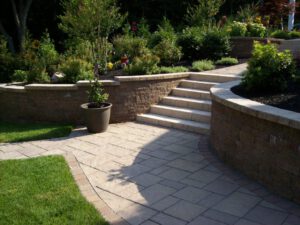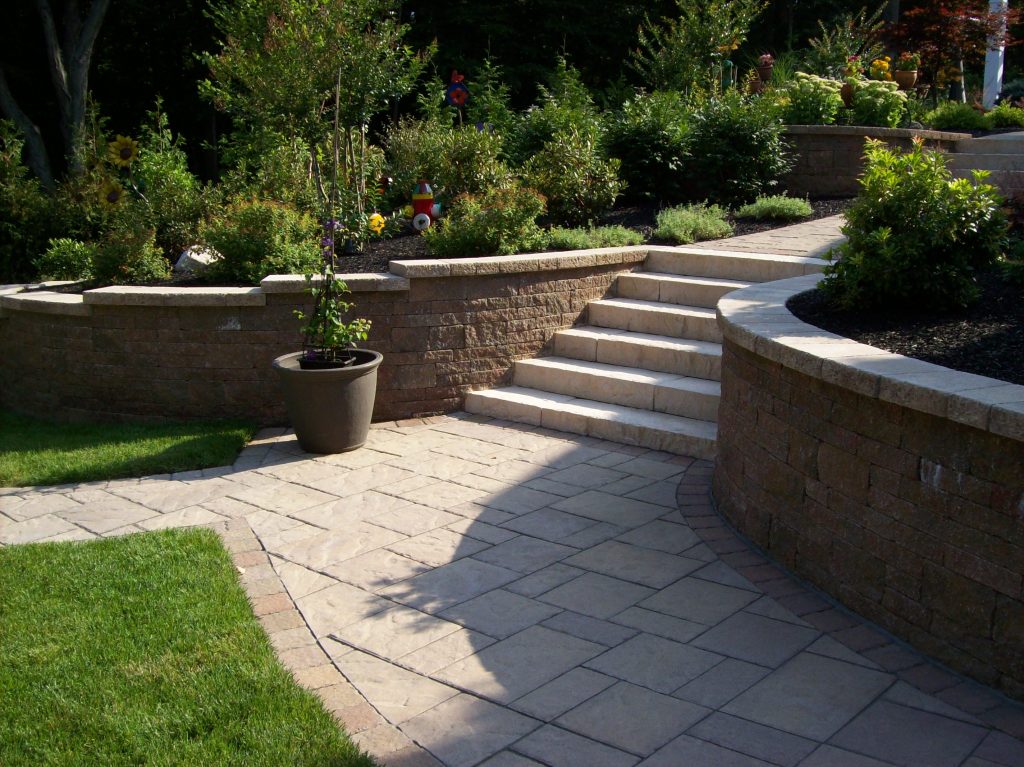Most people think of landscaping and picture organic elements like flower beds and gardens. However, a growing movement is focusing on hardscape or inorganic landscape features.
From stone pathways to outdoor patios and even a fire pit, hardscape design creates cozy outdoor spaces for entertaining or relaxing. These projects can also increase the value of your property. Read on Vanta Outdoors for more information.
Retaining walls are an important part of hardscape construction because they add aesthetics to your landscape and serve a functional purpose. They can be built to prevent soil erosion, which is a common problem in yards that don’t have many trees and bushes to keep the dirt in place naturally. Additionally, retaining walls help reduce flood damage by diverting water away from the home. They can even decrease surface runoff by lowering steep slopes.
There are many different types of retaining wall designs that homeowners can choose from. Some feature a seamless interlocking system of concrete blocks that is sturdy and fortified, while others use natural stone to give the wall a more rustic feel. Some retaining walls are curved while others are straight, and still other walls feature a mix of materials.
One of the most common uses for retaining walls is in gardens or backyards with small hills. These walls are designed to stabilize the soil and protect it from sliding downhill during a rainstorm or heavy wind. They can also be built to create terraced planting areas and reclaim space that might otherwise be unusable.
Another way that retaining walls can help is by protecting homes from sinkholes, which are created when water slowly dissolves carbonate rocks underneath the ground. These walls are especially useful in geographical regions that are prone to sinkholes, as they decrease the chance of soil collapsing under the house and damaging it.
Many retaining walls have additional functions that make them worthwhile for homeowners, such as acting as a fence or defining property lines. These features can be a nice addition to a yard and increase the value of the property.
A retaining wall can be used to create a garden or raised flower beds that provide a beautiful and unique look to a yard. These walls are ideal for gardens with small hills because they can add structure to the landscape while making it easier to plant flowers and other plants in the area. Additionally, a retaining wall can provide opportunities for additional seating in your yard as well.
Stone Steps
Stone steps take a simple functional necessity and turn it into a landscape feature that adds character. They can be rough and provide a rustic facade or smooth and refined. They can also be integrated into the existing garden or front entrance of your home, making them a dramatic focal point that is difficult to duplicate with any other material.
Whether you are looking to create a winding staircase in the side of a hill, a set of steps for a garden, or even just a set of steps for your front entrance, our team can help. We offer a wide variety of different types of natural stone that can be used for your steps depending on the look you are going for in your yard.
If you are wanting to create a more rustic look you can use large pieces of stone for the treads and smaller stepping stones for the risers. In this example, we chose to use a nice bluestone for the treads and a natural travertine for the risers. Other options include sandstone, which is a very durable and comes in a large number of colors, or slate which is a beautiful and timeless option.
The other advantage to using stone for your stairs is that it requires less maintenance than concrete. This is because the stone will not crack or chip like concrete does, and it will hold up better to the weather conditions in your area. You can simply sweep off debris and rinse them down with a hose to keep them clean.
Stone steps are a great way to add natural character to your landscape while adding value to your home. They are a much more appealing option than plain concrete and will give your property a more unique and inviting appearance that is sure to impress any guest who visits your home.
Pergolas or Gazebos
Pergolas and gazebos offer shade and definition to outdoor living spaces. Both can be built with a variety of materials and styles to fit the aesthetic of your landscape and home. They are often confused, but the key difference is in the roof: a pavilion features a completely closed roof while a pergola has open slats that allow some sunlight through.
In addition to their aesthetic appeal, both structures can create a cool retreat under which to enjoy a backyard barbecue on a warm summer evening or a cozy spot to sit around your new outdoor fire pit on a crisp fall night. Gazebos and pergolas can also be used to connect areas of a garden or yard for a defined space where people can gather.
The amount of shelter provided by a pergola or gazebo depends on how it is designed: some have a lattice roof that only allows for partial shading while others are more solid, offering more protection from the elements. A pergola is generally less expensive to build than a gazebo. It is also possible to add a canopy or vines to a pergola for additional shading and privacy.
Both structures can be built with a variety of materials, including wood, vinyl, painted wood, PVC and stone. They can be freestanding or attached to a wall of a house or other structure. The most common construction method is to sink posts into the ground and attach beams horizontally to them using rafters, which connect the crossbeams on top.
A gazebo, on the other hand, can be very expensive and complicated to build. It is also difficult to add a permanent roof to a gazebo, but it is possible to add a retractable canopy that provides more shade and weather protection. Both structures require regular maintenance to keep them looking their best. In particular, wood structures may need to be stained or sealed to protect them from the elements. In addition, any plants that are entwined with the structure will need to be maintained and pruned regularly. Gazebos that have a fabric cover will need to be replaced periodically, as well.
Water Features
When most people think about landscaping, they automatically picture organic elements – flower beds, trees, vines and the like. But what’s getting more and more attention are the inorganic hardscape features, such as patios, walkways and retaining walls.
Water features can enhance the beauty and comfort of any outdoor space. They add the soothing sounds of flowing water to your landscape and are often a focal point that ties your outdoor living spaces together. A pond, waterfall or fountain can make your garden or yard feel more inviting and relaxing, providing an escape from the everyday hustle and bustle.
Depending on the size and style of your water feature, you can also add lighting for extra appeal. For example, for ponds and brook-like features, it is popular to add a LED light that shines on the surface of the water, creating a magical effect at night.
One of the most important things to keep in mind when considering a water feature is that it requires regular maintenance, just like any other part of your landscape. You will have to monitor the water level, clean out the equipment (pump, filters, liner), remove any debris and sometimes even add chemicals to keep the water clear and healthy.
Another thing to consider when choosing a water feature is the location. It should be easily visible from your home and away from any plant beds that might get runoff. You also want to avoid areas that flood during heavy rains, as this can lead to pond overflow and pollution of the soil and water.
If you do decide on a water feature, find a designer who listens to your concerns and understands what it will take to keep your landscape looking its best. Once you have had a frank discussion with your designer about the pros and cons of water features, then you can move forward with this exciting new addition to your landscape.

